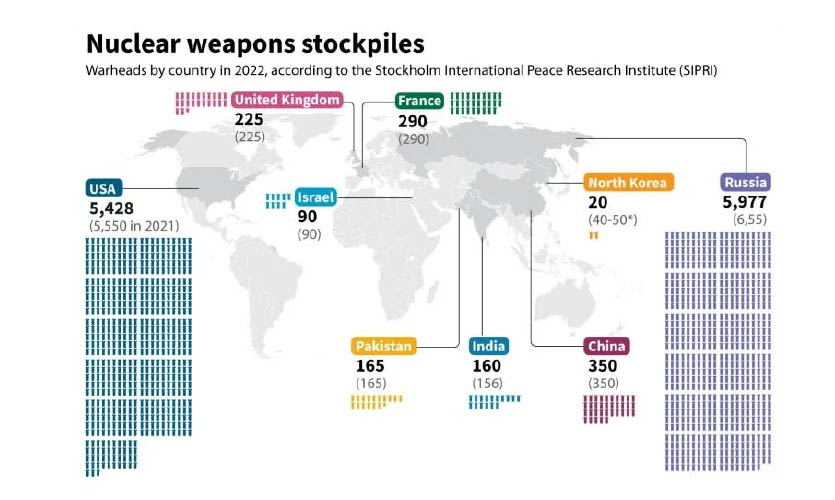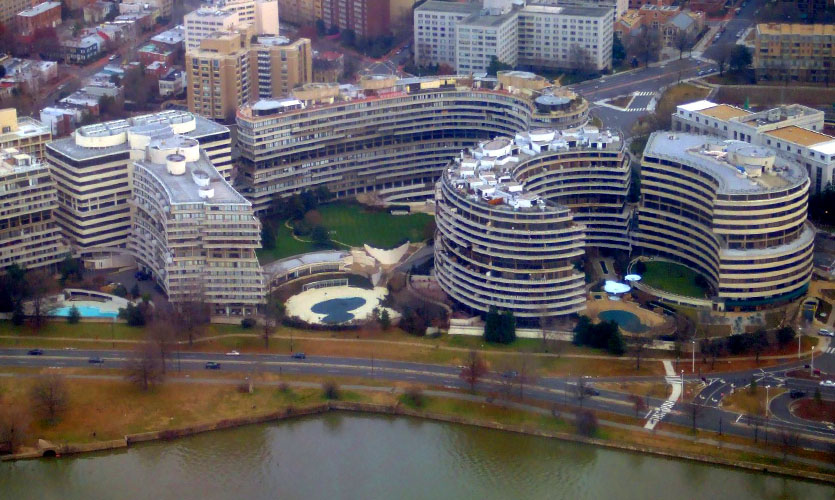On June 13, the Stockholm International Peace Research Institute (SIPRI), a Sweden-based think tank, released its annual report that shows an increase in the world’s stockpiles of nuclear weapons, indicating an end to the reductions seen since the Cold War concluded. According to the report, all nine nuclear-armed countries are increasing or upgrading their nuclear arsenals, and the stockpiles are expected to rise over the coming decade.
“All of the nuclear-armed states are increasing or upgrading their arsenals and most are sharpening nuclear rhetoric and the role nuclear weapons play in their military strategies…This is a very worrying trend,” said Wilfred Wan, the Director of SIPRI’s weapons of mass destruction programme, in a statement.
The SIPRI’s 2021 yearbook indicates that there are a total of nine countries that currently possess nuclear weapons: the United States (5428), Russia (5977), China (350), France (290), the United Kingdom (225), Pakistan (165), India (160), Israel (90) and North Korea (20). Notably, Israel has never publicly acknowledged having such weapons.
While the US and Russia hold at least 90 percent of the world’s atomic weapons, their inventories seem to have declined in 2021, reportedly due to the two countries dismantling long-retired nuclear warheads. Additionally, their usable stockpiles remained stable and within the limits agreed upon by a nuclear arms reduction deal.

According to the SIPRI, by the beginning of this year, the global inventory of warheads had declined to 12,705 from over 34,000 at the start of this century. “There are clear indications that the reductions that have characterised global nuclear arsenals since the end of the Cold War have ended,” said Hans M Kristensen, a researcher at SIPRI’s weapons programme and director of the nuclear information project at the Federation of American Scientists.
The report claims that India’s nuclear stockpile increased from 156 in January 2021 to 160 in January 2022, while Pakistan’s remained at 165 during the same time. On the other hand, China is reportedly in the middle of a “substantial expansion” of its nuclear arsenal, based on the satellite images that include the construction of 300 new missile silos.
While the number of warheads that China possesses stood consistently at 350 during the same period of time, the report noted that “the number of stockpiled warheads potentially available for use has changed because new launchers became operational during 2021”. According to the report, both India and Pakistan appeared to be expanding their nuclear arsenals in 2021, and both seem to have introduced and continued developing new types of nuclear delivery systems. There is no official data shared by India on its nuclear arsenal, as per the Indian government’s policy.
This was also noted in a statement by the SIPRI. “The availability of reliable information on the status of the nuclear arsenals and capabilities of the nuclear-armed states varies considerably. India and Pakistan make statements about some of their missile tests but provide no information about the status or size of their arsenals,” it read. Meanwhile, the Indian officials have indicated that while the country is steadily moving forward to modernise its nuclear capabilities with better delivery, it remains in tune with its declared policy of “credible minimum deterrence” and “no first use”.
India has had a tense relationship with the neighbouring nuclear-capable countries. The country’s borders with both China and Pakistan have been consistently disputed and contested. Recently in 2020, India and China were involved in a number of skirmishes along the Line of Actual Control (LAC), where each side has now placed 50,000-60,000 troops. 15 rounds of military talks have been held to resolve the eastern Ladakh stand-off, which has resulted in disengagement on the north and south banks of the Pangong Lake.
On the other hand, the West has been concerned over the efforts taken by China and North Korea to expand their nuclear arsenal. The SIPRI report also comes a day after China’s Defence Minister Wei Fenghe remarked at the Shangri La Dialogue in Singapore that his country has made “impressive progress” in the development of new nuclear weapons.
Read more: Ukraine Has Run Out Of Soviet-era Weapons, Dependent Solely On Arms Sent By Allies
Furthermore, he defended Beijing’s stance on the issue when questioned. “China has always pursued an appropriate path to developing nuclear capabilities for (the) protection of our country,” said Wei. He added that they did so “to protect the hard work of the Chinese people and protect our people from the scourge of nuclear warfare”.
The US, reportedly, suspects that North Korea is preparing to conduct its seventh nuclear test. According to the think tank, “North Korea continues to prioritise its military nuclear program as a central element of its national security strategy… the country’s inventory of fissile material is believed to have grown in 2021.” The SIPRI also believes that Pyongyang has enough fissile material to build over 50 nuclear warheads.
Meanwhile, Russia’s invasion of Ukraine has renewed the risk of nuclear conflict. Earlier this year, in February, during the onset of the invasion, Western intelligence officials reportedly warned that Moscow might resort to tactical nuclear weapons if it continues to struggle in Ukraine. “Although there were some significant gains in both nuclear arms control and nuclear disarmament in the past year, the risk of nuclear weapons being used seems higher now than at any time since the height of the Cold War”, said SIPRI Director Dan Smith. Notably, earlier this year, the world’s five biggest nuclear powers and the UN Security Council permanent member nations released a joint statement affirming that a “nuclear war cannot be won and must never be fought”.










